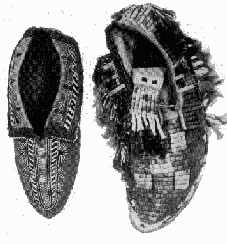
Knife Sheaths (Orchard 1984)
Porcupine Quill Embroidery
by Tara Prindle

Knife Sheaths (Orchard 1984) |
Native Americans in 17th century New England were long familiar with quill embroidery, they used porcupine quills to decorate their clothing and accessories, and to decorate containers of birchbark as well. European accounts from the 1600's refer to several dye colors (black, blue, red and yellow for examples) for porcupine quills embroidered on baskets, bags and mats.
A few rare examples of 17th century hemp and basswood bags have survived the centuries. A Mohegan bag woven of Indian Hemp in the 1600's has a design embroidered with purple-black porcupine quills. The design on the Mohegan bag consists of two thin horizontal bands of solid color placed within three thicker bands of solid color which has been further broken into a series of geometric diamond and triangular shapes around the circumference of the bag. Other accounts from the 1600's describing New England Native Americans, include descriptions of designs: birds, beasts, fishes and flowers in colors placed upon baskets.

Moccasins (Orchard 1984) |
Dyed quills decorated moccasins in red, blue and violet; to the north, moose skin robes were dressed white and embroidered top to bottom a finger's breadth wide, with closed or open work figures of animals. Quill embroidery embellished the Penobscot pouches and bags of deer or mole skin. Exquisite Maliseet-Passamaquoddy quilled birchbark containers were not often produced after Native splint and sweetgrass basket manufacture became popular in the 1700's.
In general, quillworking flourished among Native Americans until the mid-1800's when glass beads became easily attainable through trade with Europeans. Later traditions of embroidery using glass beads were built upon techniques and designs in quillworking. Although considered a 'lost art' by many, Native Americans such as the Sioux, Cree and Ojibway and others still carry on the tradition of quill embroidery.
Return to NativeTech's Main Porcupine Quillwork Menu

|
Text and Graphics
© 1994 - Tara Prindle unless otherwise cited. |